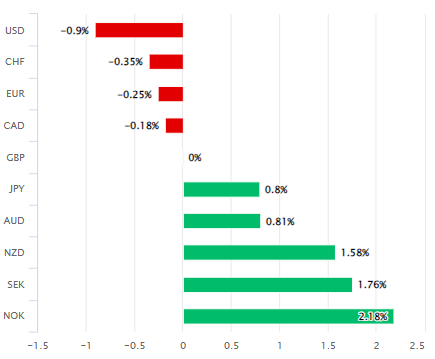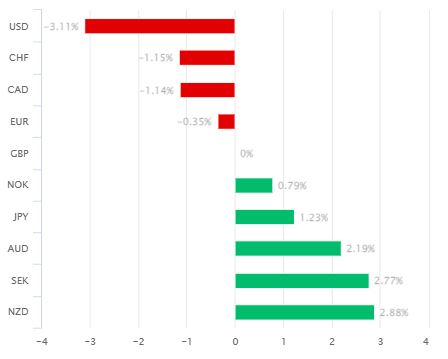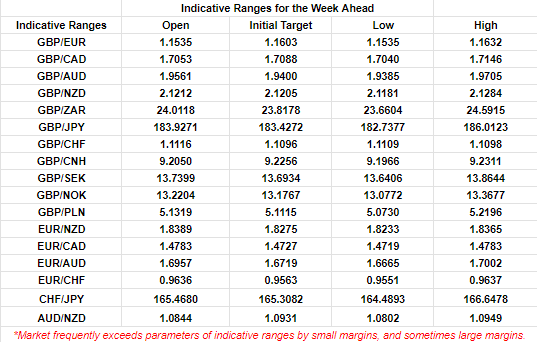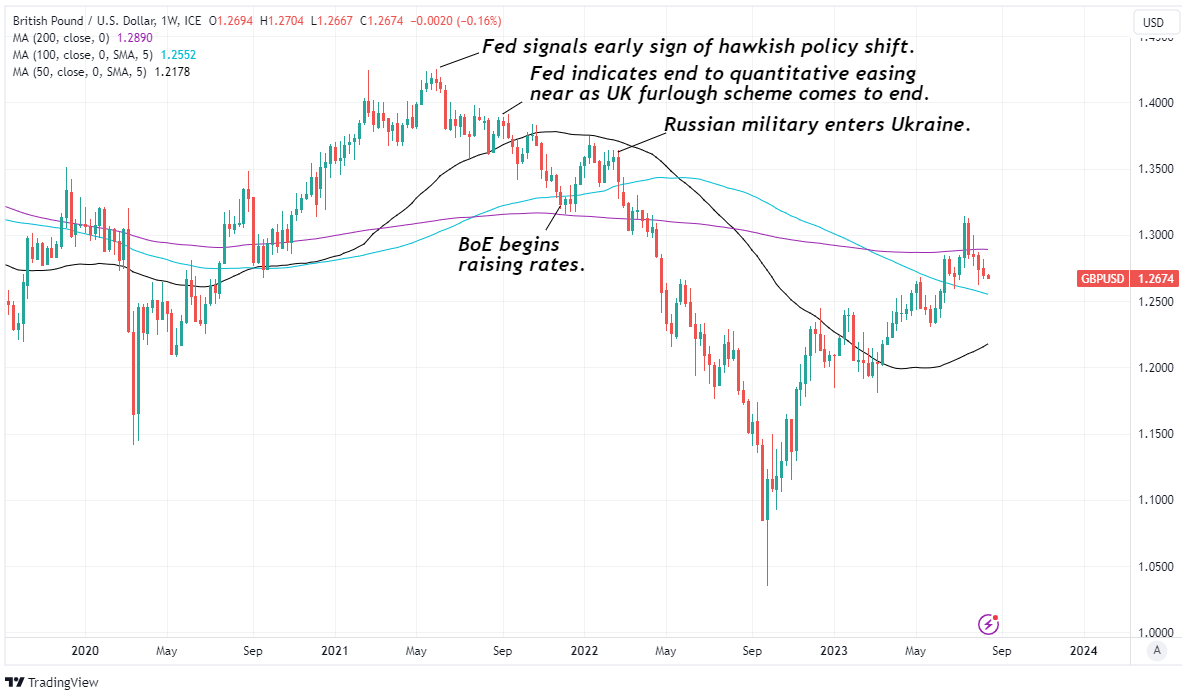GBP/USD Week Ahead Forecast: Recovery Momentum Ebbs Above 1.28
- Written by: James Skinner
- GBP/USD supported near 1.26 & 1.2550 on chart
- UK employment figures an upside risk short-term
- UK’s inflation data a possible dampener midweek
- U.S., UK retail data both wild cards for GBP/USD

Image © Adobe Images
The Pound to Dollar exchange rate has receded sharply from the highs of early July but the risk now is that any attempted recovery is held back from Wednesday by a further ebbing of the inflation tide in the UK, potentially leaving Sterling unable to sustain any advance beyond the 1.28 level for the week.
Sterling entered the new week near important technical support around 1.26 on the charts after UK economic growth figures came in much stronger than expected for the second quarter on Friday only for the resulting rally to fade quickly ahead of the weekend.
Friday's dampening of market appetite led the Pound to end last week in the red against the Dollar while leaving it in the middle of the major currency league table for the period with the Canadian Dollar, Euro and Swiss Franc the only others to get ahead.
Sterling has risen the most in relation to the New Zealand Dollar, Swedish Krona, Australian Dollar and Japanese Yen but its prospects this week are hinged on the interest rate implications of the latest flurry of economic figures out from Tuesday.
“We doubt that July’s CPI figures, due next Wednesday, will have a decisive impact on markets, which are pricing in around an 80% chance of a 25bp increase in Bank Rate at the MPC’s next meeting on September 21,” says Samuel Tombs, chief UK economist at Pantheon Macroeconomics.
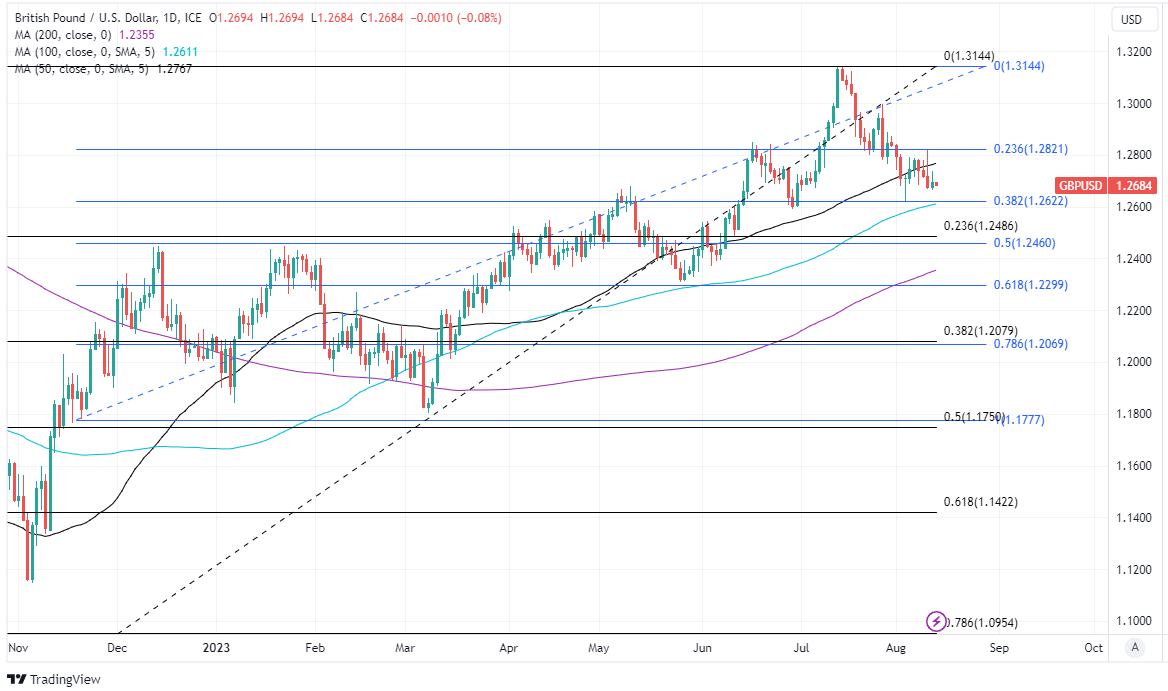
Above: Pound to Dollar rate shown at daily intervals with Fibonacci retracements of second-quarter rally and selected moving averages denoting possible areas of technical support.
GBP to USD Transfer Savings Calculator
How much are you sending from pounds to dollars?
Your potential USD savings on this GBP transfer:
$318
By using specialist providers vs high street banks
“The headline rate likely fell to 6.8%, from 7.9% in June, matching the BoE’s forecast in last week’s Monetary Policy Report,” he adds in a research briefing last Thursday.
Wednesday’s release of inflation figures for July is the highlight of the week and month given their potentially significant implications for the Bank of England (BoE) interest rate outlook but the knock-on effect for the Pound is likely to be a dampening one if the economist consensus is anything to go by.
The consensus suggests inflation likely fell sharply to around 6.9% in July and that the more important core inflation rate eased from 6.9% to 6.8% with the difference being in how statistical base effects and other factors have impacted food and energy prices.
The expected declines in inflation, or any larger falls, would place a question mark over the widely held assumption that Bank Rate is likely to be raised further from its current 5.25% in September and could dampen market appetite for the Pound, although there are other reasons for why midweek losses might be only limited.
Above: Pound Sterling performance relative to G10 currencies for the recent week (left) and month (right). Source: Pound Sterling Live.
“Retail gas and electricity prices fell 17% in July as previous declines in wholesale energy prices were finally reflected in household bills. This move alone will have knocked almost 1ppt off annual inflation, which stood at 7.9% in June,” says Andrew Goodwin, chief UK economist at Oxford Economics.
Falling inflation is a negative influence for currencies when it leads market expectations for interest rates to fall, although the pecking orders of performance among major currencies for the recent week and month has favoured those currencies and countries where inflation has fallen back the furthest this year.
The latter is one reason why any losses for the Pound could be limited in the midweek trading session, and meanwhile Sterling potentially stands to benefit on Tuesday if it turns out the economist consensus is right to anticipate further increases in both main measures of average wage growth in the employment figures for June.
“The July REC/KPMG labour market survey saw another tick lower in the permanent salaries index (58.3, -0.3). Pre-COVID, this measure had been a good lead indicator of the official ONS measure of core private sector wage growth,” says Abbas Khan, an economist at Barclays.
Above: Quantitative model estimates of possible ranges for the week. Source: Pound Sterling Live.
GBP to USD Transfer Savings Calculator
How much are you sending from pounds to dollars?
Your potential USD savings on this GBP transfer:
$318
By using specialist providers vs high street banks
“Most recently, the continued acceleration in the official data has led to a decoupling versus the survey's suggestion that wage growth should have peaked. This has created risks that it may have lost its leading properties in the current high inflationary environment (in which it has not previously been tested),” he adds on Friday.
When workforce bonuses are set aside, average annual wage growth rose above 7% in April following a near double-digit percentage increase in the national minimum wage and remained unchanged at the same level in May but remains to be seen if and how such a rate of pay growth could be sustained into June.
Nonetheless, the economist consensus is for a further uptick from 7.3% to 7.4% on Tuesday ahead of the midweek inflation report and the retail sales figures out on Friday, the latter of which forecasters are less optimistic about: The average of economist forecasts suggests June's 0.7% increases was partially reversed by a -0.4% fall in Jult.
With Tuesday’s release of U.S. retail sales data for June set aside, UK economic numbers are this week’s main focus for the Pound to Dollar rate, which might get an opportunity to climb back toward or even above 1.28 but might have difficulty building further on any recovery from there.
“We're doubtful that July's retail performance will have repeated the previous month's strong gain. June's 0.7% m/m rise in retail sales volumes looks to have been supported by unusually warm weather, a factor noticeably absent the following month,” Oxford Economics’ Goodwin says on Friday.
Above: Pound to Dollar rate shown at weekly intervals with selected moving averages denoting possible support and/or resistance for Sterling.

